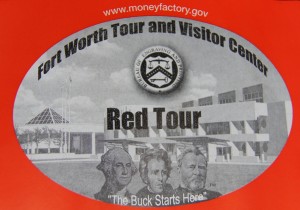What would it be like to work surrounded by almost a billion dollars? I found out with a trip to the Money Factory. Located in Fort Worth, the Money Factory (also known as the  Bureau of Engraving and Printing or BEP) conducts free tours of its facility, one of only two locations that print U.S. currency.
Bureau of Engraving and Printing or BEP) conducts free tours of its facility, one of only two locations that print U.S. currency.
The buck starts here! Imagine printing presses churning out sheets of hundred dollar bills. Or pallets stacked with money bricks, 400 notes to a brick. On any given business day, the Fort Worth BEP produces 36 million notes valued at $526 million.
The tour is conducted from a glassed-in, elevated walkway above the factory floor. Visitors see all three types of printing processes used to make money.
- The intaglio printing pushes ink into the sheet giving money its three dimensional, textural feel.
- The off-set press gives higher denomination bills their color.
- The letter-press printing process serializes the notes.
Between each printing step, currency sheets dry in controlled areas on pallets.
Laundering money. Guides provide fun facts throughout the Money Factory tour. I learned that paper currency is actually a misnomer. U.S. notes are printed on specially designed sheets made of cotton and linen fibers. The fiber blend prevents money from falling apart in a washing machine or tearing when it’s folded too many times. To meet BEP quality assurance standards, currency must be able to withstand six washing machine encounters!
What you won’t see. The Money Factory has just one customer, the Federal Reserve Bank. Security restrictions prevent BEP visitors from viewing the 19,000-square- foot Federal Reserve vault that stores the finished currency prior to its shipment to one of the 12 Federal Reserve banks.
Learn about BEP. A self-guided walk through the visitor center is almost as much fun as the factory tour. Interactive exhibits and displays provide detailed information on all the engraving and printing processes involved in currency production. My favorite exhibit told the story of the Mutilated Currency Division. They refund damaged money, like currency damaged by fire or flood. The most outlandish example of the division’s work involved a man and his money eating cow. The man killed the cash consuming cow and sent the damaged currency (still in the bovine’s stomach) to the Mutilated Currency Division. And yes, he did get his money refunded.
Early counterfeiters. I also learned about the history of money and counterfeiting. Cacao beans were used as currency by the Aztecs. Some would counterfeit the cacao bean by removing its meaty center and replacing it with mud. Today’s counterfeiters are more sophisticated and BEP uses a variety of measures to foil attempts to counterfeit currency including the use of color shifting ink, security strips and more.
The 10 cent note. Surprisingly, the United States didn’t use paper currency until the Civil War. In 1861, the Treasury printed fractional currency in denominations of 3, 5, 10, 25 and 50 cents to offset coin hoarding. Today, BEP produces $1, $2, $5, $10, $50 and $100 notes. The largest denomination printed was the $100,000 note used only between banks prior to the advent of electronic fund transfers.
When you go. The Money Factory in Fort Worth is located at 9000 Blue Mound Road. Public tours are Tuesday through Friday (except federal holidays) from 8:30 a.m.to 4:30 p.m. All visitors must pass through security. BEP advises people to allow up to a half hour for the security check during its busiest times (spring and summer break). Cell phones, cameras, backpacks and any sort of weapon including pocket knives are strictly forbidden. For more information call the visitor center at (817) 231-4000.
